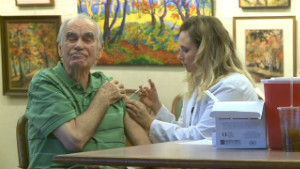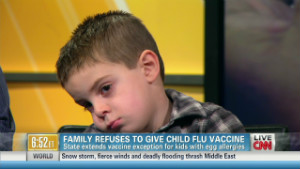A fierce spread of the flu is spreading across the United States.http://bit.ly/ZIs2Se #flu #illness #health
11:00 AM - 10 Jan 13 · Details
The flu has been spreading fiercely across the United States, with more than half of states reporting widespread activity. The season has started earlier, and cases are more severe than last year, health officials say.
The latest Centers for Disease Control and Prevention flu advisory report, which covers the week of December 23 to 29, suggests that 41 states have widespread influenza activity, which was an increase of 31 states from the previous week. The CDC will issue an update on the flu situation Friday.
There have so far been 2,257 hospitalizations associated with laboratory-confirmed flu virus, the CDC report said. Among children, there have been 18 deaths reported during this season.
 Flu cases spike across country
Flu cases spike across country How to avoid catching the flu
How to avoid catching the flu 4-yr-old banned for not getting flu shot
4-yr-old banned for not getting flu shot Dealing with the flu
Dealing with the flu
In Massachusetts, one of the 29 states that the CDC has identified as having high activity of influenza-like illness, Boston Mayor Thomas Menino declared a public health emergency in the city because of the flu.
Since October 1, there have been 700 confirmed influenza cases among Boston residents, according to Menino's office; that's 10 times more than were seen in all of last year's flu season.
Menino is collaborating with the Boston Public Health Commission and community health centers to offer free vaccination clinics this weekend. The mayor urged residents to stay home from work or school if they are sick, and to get their flu shots.
"This is the worst flu season we've seen since 2009, and people should take the threat of flu seriously," Menino said in a statement. More than 4% of emergency department visits at Boston hospitals are from flu cases, up from 1% during non-flu season.
Massachusetts General Hospital has already counted 532 cases of flu among patients, which is more than the hospital saw in any of the previous three flu seasons, said spokeswoman Kristen Stanton.
Signs posted throughout the hospital discourage anyone from visiting who has a cough or fever, she said, and anyone who does visit with those symptoms must wear a mask and perform hand hygiene. All staff must wear a mask when providing care for possible flu cases. Any staff member who has not been vaccinated must wear a mask while caring for any patient.
Pennsylvania has had 22 flu-related deaths so far this season, according to data from the state's Department of Health. Most of these deaths occurred among people older than 65, but the fatalities included two individuals younger than 50 who were otherwise healthy.
Lehigh Valley Hospital-Cedar Crest in Allentown, Pennsylvania, set up a heated tent outside the hospital to serve as a clinic. Anyone with mild flu symptoms can be treated quickly and discharged, isolated from more serious cases. The hospital has been seeing an additional 80 to 100 patients with flu-like symptoms daily, officials told CNN affiliate WPVI.
South Carolina also has counted 22 flu-related deaths this season, compared with one for all of 2011, according to the South Carolina Department of Health. From September 30 through last Saturday, the state saw 1,084 influenza-related hospitalizations, the department said.
In Illinois, Department of Public Health Director Dr. LaMar Hasbrouck said Wednesday that since October, six flu-related deaths of patients in intensive-care units have occurred.
"We have been and continue to see an increase in flu activity across the state. The flu strain that is predominately circulating this year is typically more severe, with more hospitalizations and deaths," Hasbrouck said. "From the beginning of October through the end of December we've seen almost 150 people admitted to hospital intensive care units (ICU) with influenza like illness.
"This compares to last year at this time when there were only two ICU hospitalizations and no deaths."
In Michigan, there have been four pediatric deaths related to the flu, said Angela Minicuci, public information officer for the Michigan Department of Community Health.
And the North Dakota Department of Health is reporting 1,077 cases of flu in the state as of Wednesday -- a sharp increase from the 625 cases reported last week.
Dr. David Zich, internal medicine and emergency medicine physician at Northwestern Memorial Hospital in Chicago, said this is the worst flu season he's seen in his 12 years at his hospital, in terms of the concentration of patients.
Northwestern Memorial Hospital is on "bypass," which happens when it is beyond capacity because of an influx of patients, such as during flu season.
That means advanced-life support ambulances with patients who are stable are referred to the next closest hospital, no more than five minutes away, Zich said, and transfers are not accepted from outside hospitals. For everyone else, they are open for business.
"The majority of flu patients are sent home, with very little else done, so we can handle that," he said.
Why so many cases?
Zich theorizes that one reason there are so many flu cases is that the heart of the flu season coincided with the December holiday season, meaning many people were already sleep-deprived from parties and were more likely to get sick.
Those who went to gatherings of family or friends may have already begun to feel sick, and spread the virus to others. People are generally contagious the day before symptoms start, and for five days after becoming sick, according to the Centers for Disease Control and Prevention.
Last flu season was light, but this year has brought with it some "ominous signs," Dr. Anthony Fauci, director of the National Institute of Allergy and Infectious Diseases at the National Institutes of Health, told CNN's Wolf Blitzer Tuesday.
Flu cases started going up early, toward the end of November and the beginning of December, he said.
"And it went up on a pretty steep trajectory," he said. "The last time we saw that happen that way was the flu season of 2003 and 2004, which turned out to be a bad flu season."
The type of flu that is going around is called H3N2, which is often linked to more serious disease compared to other flu varieties, Fauci said.
But there's good news: That type of flu matches up well to the vaccine that is being distributed and given out throughout the United States.
People may get more complications from this particular strain of H3N2, "which may make them ill for a longer period of time," Dr. Michael Jhung, medical epidemiologist in the influenza division at CDC, told CNN's Mary Snow.

